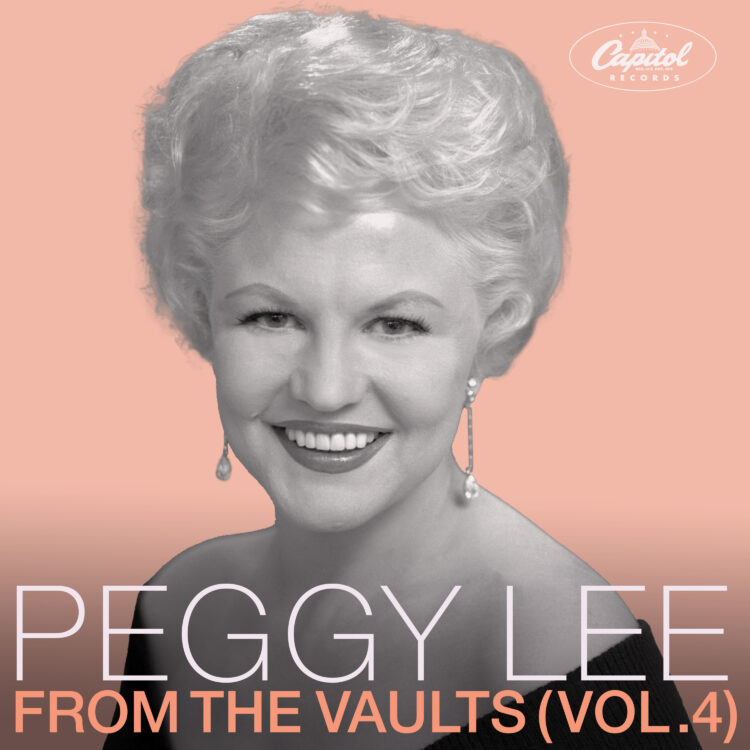Capitol Records / Universal Music Enterprises
Release date: February 14, 2025
LOS ANGELES, CA – February 14, 2025 – Capitol Records and Universal Music Enterprises (UMe), in conjunction with Peggy Lee Associates, today release Peggy Lee: From the Vaults (Vol. 4), the final installment in the new digital series that features rare tracks previously unavailable on streaming platforms.
Recorded for Capitol and Decca Records between 1947 and 1967, the 13 selections on From the Vaults (Vol. 4) include duets with then-emerging vocalists Dean Martin and Mel Tormé; collaborations with distinguished jazz instrumentalists George Shearing and Toots Thielemans; homages to the cartoon characters Batman and Mr. Magoo, the latter featuring comic actor Jim Backus; and several tracks with vocal group backing. Six of the collection’s 13 tracks were written or co-written by Peggy Lee during an era when popular and jazz vocalists very rarely wrote the songs they recorded.
Peggy Lee’s 1948 duet with Dean Martin, “You Was,” dates from one of Martin’s first recording sessions for Capitol in a label affiliation that lasted 14 years and produced dozens of hit singles and albums. The only one among this collection’s 13 tracks to previously be available digitally, “You Was” is included here in improved sound quality. Although it was the sole Lee-Martin duet on record, Martin recorded solo versions of three songs Lee co-wrote, and the two artists sang duets on ten episodes of Martin’s television variety show in the 1960s and 1970s. Lee’s professional relationship with singer-songwriter Mel Tormé began in 1949 (here represented by the 1949 duet “Bless You [For the Good That’s in You],” co-written by Lee and Tormé, as well as 1951’s “Don’t Fan the Flame”), and continued with other duet pairings on record, radio and television. Lee and Tormé also co-headlined concert stages, including at Lee’s final concert performance in 1995.
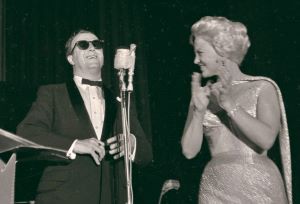
Beloved jazz pianist George Shearing is featured on the collection’s opening track, “Always True to You in My Fashion,” a song from Cole Porter’s masterwork, Kiss Me, Kate. This rare live recording with Shearing and his quintet is taken from a 1959 disc jockey convention in Miami that was to have been released on the Capitol album Beauty and the Beat! but was ultimately replaced by studio recordings due to technical flaws in other portions of the live recording. Another track, from 1967, features jazz harmonicist and guitarist Toots Thielemans accompanying Lee on Walter Donaldson’s “You’re Driving Me Crazy,” an outtake from Lee’s Capitol album Something Groovy! (1967). Other distinguished jazz personnel on From the Vaults (Vol. 4) include Sy Oliver, conductor on the Decca version of “Swing Low, Sweet Chariot” (Lee had previously recorded the spiritual for Capitol), and several prominent jazzmen – among them Benny Carter, Billy May and Red Norvo – featured on “Ja-Da,” an instrumental track that features Lee performing on drums as part of Capitol’s stunt configuration Ten Cats and a Mouse.
Lee was very rarely backed by vocal groups in her catalog of over 1,100 masters, but they are heard here on the tracks “When You Speak with Your Eyes” (with the Guadalajara Boys, a song co-written by Lee, her first husband, Dave Barbour, and Cuban composer, pianist and bandleader Rene Touzet), “Wandering Swallow” (with the Jud Conlon Singers, with whom Lee frequently sang on Bing Crosby’s radio show), and an unidentified group on “Swing Low, Sweet Chariot.”
From the mid-1950s come two whimsical songs involving the popular cartoon character Mr. Magoo voiced by comic actor Jim Backus: “Three Cheers for Mr. Magoo” and “Mr. Magoo Does the Cha Cha Cha,” both written by Lee, the latter in collaboration with jazz pianist Gene DiNovi. From the mid-1960s comes another cartoon homage, this time to Batman, who was then at the height of his popularity through the ABC television series. Lee co-wrote the comic number “That Man” with her longtime Capitol producer Dave Cavanaugh, incorporating “Pow!,” “Zowie!,” and other exclamations regularly featured on the program.
With the release of the four-volume From the Vaults digital series, Lee’s entire catalog of issued master recordings from the Universal family of labels — Capitol, Decca, A&M, and Polydor — now becomes fully accessible via digital streaming.
To read about previous volumes of From the Vaults: Vol. 1 | Vol. 2 | Vol. 3.
Track Listing
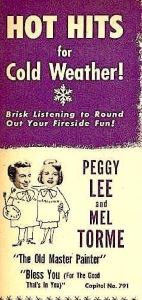
1. Always True to You in My Fashion (Cole Porter) Recorded May 29, 1959 – featuring George Shearing
2. You’re Driving Me Crazy (Walter Donaldson) Recorded June 7, 1967 – featuring Toots Thielemans
3. Mister Magoo Does the Cha Cha Cha (Gene DiNovi, Peggy Lee) Recorded June 3, 1955 – featuring Jim Backus
4. Don’t Fan the Flame (Hal Dickinson, Jack Elliot) Recorded July 10, 1951 – duet with Mel Tormé
5. Three Cheers for Mister Magoo (Peggy Lee) Recorded June 3, 1955 – featuring Jim Backus
6. That Man (Dave Cavanaugh [using name Bill Schluger], Peggy Lee) Recorded February 1, 1966 – alternate version with character sound effects
7. Bless You (For the Good That’s in You) (Peggy Lee, Mel Tormé) Recorded November 16, 1949 – duet with Mel Tormé
8. You Was (Sonny Burke, Paul Francis Webster) Recorded December 14, 1948 – duet with Dean Martin
9. My Small Señor (Dave Barbour, Peggy Lee) Recorded December 2, 1949 – featuring the Guadalajara Boys
10. Wandering Swallow (Harold Stevens, Irving Taylor) Recorded May 16, 1951 – featuring the Jud Conlon Singers
11. When You Speak with Your Eyes (Dave Barbour, Peggy Lee, Rene Touzet) Recorded December 2, 1949 – featuring the Guadalajara Boys
12. Ja-Da (Bob Carleton) Recorded October 13, 1947 – instrumental by Ten Cats and a Mouse
13. Swing Low, Sweet Chariot (Traditional) Recorded January 6, 1956 – accompanied by Sy Oliver
Song Notes
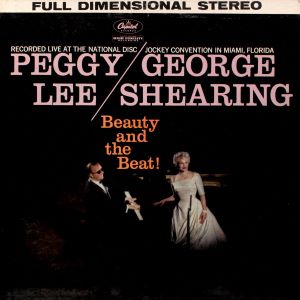
- Always True to You in My Fashion (Cole Porter) Recorded May 29, 1959; featuring George Shearing
In May of 1959, Peggy Lee teamed with popular English jazz pianist George Shearing and his quintet in the ballroom of the Americana Hotel in Miami, Florida to record a live album before a convention audience filled with radio disc jockeys and other music industry professionals. The album, Capitol’s Beauty and the Beat!, was presented as a live recording but – as was not uncommon in the early LP era – actually consisted of studio recordings (including spoken introductions) enhanced by applause. In this case it was done out of necessity. Technical flaws with most of the live recordings forced Lee, Shearing and quintet (Ray Alexander, vibes; Ray Mosca, drums; Armando Peraza, congas, percussion; Carl Pruitt, bass; Toots Thielemans, guitar) into the studio the following month to recreate their performance for the album, which had already been promised to the conventioneers as a souvenir. This rare recording of “Always True to You in My Fashion” is taken from the actual Americana performance, where its notably slower tempo gives Lee a greater opportunity to draw out Cole Porter’s suggestive lyrics. The song originated in Porter’s theatrical masterpiece, 1948’s Kiss Me, Kate, where it was introduced by Lisa Kirk; Ann Miller sang it in the 1953 film version. Others who recorded “Always True” in its first decades include Pearl Bailey, Blossom Dearie, Ella Fitzgerald, Eydie Gorme, Eartha Kitt, Julie London, Della Reese, Dinah Shore, Keely Smith and Jo Stafford. The Lee-Shearing Beauty and the Beat! album reached #19 on Billboard’s album charts in late 1959. Japanese and American CD reissues in the early 2000s offered the studio recordings without the added effects.
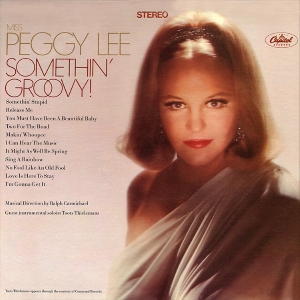
- You’re Driving Me Crazy (Walter Donaldson) Recorded June 7, 1967 featuring Toots Thielemans
This was Lee’s second version of Walter Donaldson’s song “You’re Driving Me Crazy,” which she previously recorded for a 1949 transcription record made exclusively for radio play. This version of “Crazy” hails from Lee’s 1967 sessions for the album Somethin’ Groovy!, which prominently featured guitarist and harmonicist Toots Thielemans on a typically eclectic (for Lee) assortment of both recent and time-tested songs. Lee enjoyed Thielemans’ musical company so much that she featured him as the sole guest on her 1967 Something Special television special, during which they “duetted” (with Thielemans’ harmonica as his “voice”) on “Makin’ Whoopee.” “Crazy” wasn’t included on the Groovy! album but clearly fits in nicely with it thanks to Thielemans’ distinctive contributions. The Belgian harmonicist was also heard throughout Lee’s live album of the following year, Two Shows Nightly. The song “You’re Driving Me Crazy” was introduced in 1930 through a series of popular recordings (including hit versions with vocals by Carmen Lombardo and Nick Lucas), and a performance by Adele Astaire and Eddie Foy Jr. in the Broadway musical Smiles. The many others who recorded it included Louis Armstrong, Nat King Cole, Bing Crosby, Doris Day, Billy Eckstine, Ella Fitzgerald, Billie Holiday, Patti Page, Dinah Shore, Frank Sinatra, Kay Starr, Mel Tormé and Sarah Vaughan.
- Mister Magoo Does the Cha Cha Cha (Gene DiNovi, Peggy Lee) Recorded June 3, 1955 – featuring Jim Backus
Lee spent five years recording for Decca Records between 1952 and 1956, a brief interlude relative to her long association with Capitol on either side of it. Her entire Decca catalog has become available on streaming platforms apart from three tracks included here, two of them featuring Jim Backus as his boisterous, frequently flummoxed cartoon character Mr. Magoo. A 1954 article located by discographer Ivan Santiago-Mercado indicates that Lee was then “working on songs for the UPA [United Productions of America] cartoon firm, makers of Magoo and Gerald McBoing-Boing.” UPA films featuring Lee’s songs were never produced, but the Lee-Backus duets saw release as a promotional 78 single in the US and also in the UK, where they were released on American Decca’s UK affiliate label, Brunswick. Lee has songwriting credits on both titles, collaborating with pianist Gene DiNovi on the novelty “Mr. Magoo Does the Cha Cha Cha,” in which Magoo and Lee tackle (at great physical expense) the popular Latin dance style. DiNovi’s professional association with Lee began in 1951; he played piano on her album of songs from Pete Kelly’s Blues and harpsichord on her album Sea Shells, both for Decca. Lee later recorded DiNovi’s song “I Can Hear the Music” (with Spence Maxwell) for Capitol. DiNovi also played piano on Lee’s final studio recording, “I See You,” in 1995. Also in the mid-1950s, Lee contributed as a songwriter to two major animated feature films, Walt Disney’s Lady and the Tramp (1955) and MGM’s Tom Thumb (1958).
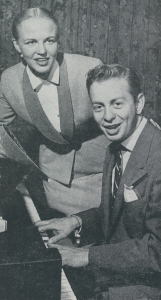
- Don’t Fan the Flame (Hal Dickinson, Jack Elliott) Recorded July 10, 1951 – duet with Mel Tormé
Peggy Lee and Mel Tormé were close collaborators in the spring and summer of 1951 in three different mediums. They resumed their occasional duet partnership for Capitol Records with “Don’t Fan the Flame” from a New York session led by Sid Feller, which shared a Capitol single with their duet “Telling Me Yes, Telling Me No” from the same session. Also in mid-1951, Tormé guest-starred on The Peggy Lee Rexall Show over CBS radio. Finally, the two appeared together on television, co-hosting several episodes of TV’s Top Tunes on CBS. Tormé wrote of that experience in his book My Singing Teachers: “In the eight weeks or so that we performed together, I learned a lot about keeping my cool and performing with restraint from Peg.” Their occasional collaborations continued into the 1960s with Lee’s CBS special 76 Men and Peggy Lee and on The Judy Garland Show, for which Tormé served as musical arranger. Their professional partnership culminated in the summer of 1995, when they co-headlined concerts at Carnegie Hall and the Hollywood Bowl. The latter proved to be Lee’s final concert. “Don’t Fan the Flame” was also recorded in 1951 by singer Connie Haines.
- Three Cheers for Mister Magoo (Peggy Lee) Recorded June 3, 1955 – featuring Jim Backus
See the “Mr. Magoo Does the Cha Cha Cha” entry above for background about this song, for which Lee has sole songwriting credit. Elaborating on a possible storyline for it, discographer Ivan Santiago-Mercado writes that “‘Three Cheers for Mr. Magoo’ conveys scenes of Magoo being feted or honored at his alma mater, and giving in the process a speech like only he could.”
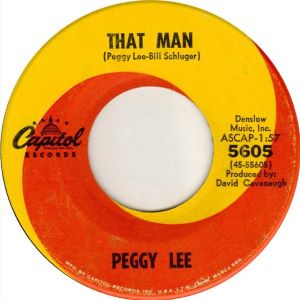
- That Man (Dave Cavanaugh [using name Bill Schluger], Peggy Lee) Recorded February 1, 1966 – alternate version with character sound effects
Such was the height of “Batmania” in the year 1966, when ABC’s Batman television series launched to resounding (Zowie!) commercial success, that thirty years later a CD compilation was released titled Batmania: Songs Inspired by the Batman TV Series. It featured songs by the rock duo Jan and Dean (“The Joker Is Wild”), R&B singer LaVern Baker (“Batman to the Rescue”), the folk group the Brothers Four (“Ratman and Bobbin in the Clipper Caper”) and, last but certainly not least, Peggy Lee’s Capitol single “That Man.” The song was co-written by Lee and her longtime producer Dave Cavanaugh (using the pseudonym Bill Schluger), the same team that co-wrote a 1960 song that has become a jazz standard, “I Love Being Here with You.” Recorded during a session for Lee’s 1966 album Big Spender, “That Man” shared a singles release with “You Don’t Know” from that album. Unlike another available version of “That Man,” this version incorporates Lee’s interjections in a character voice (“Leapin’ lizards – look at that man go!” and “Little does he know I’ve been hiding in the trunk!”), making this the only recording that reveals how she’d sound after inhaling helium. As discographer Ivan Santiago-Mercado notes, the single enjoyed modest success on Billboard’s adult contemporary chart in the spring of 1966, thus making it Lee’s “11th self-penned Billboard entry (not counting her uncredited writing contributions to the songs ‘Don’t Smoke in Bed’ and ‘Fever’).”
- Bless You (For the Good That’s in You) (Peggy Lee, Mel Tormé) Recorded November 16, 1949 – duet with Mel Tormé
Peggy Lee and Mel Tormé began collaborating as Capitol artists in November of 1949. Their efforts that month included this duet recording of a song they co-wrote, as well as their duet of Haven Gillespie and Beasley Smith’s “The Old Master Painter,” which reached #9 on Billboard’s chart in early 1950. A few days before this session led by pianist Lou Busch and featuring backup vocals by the Mellomen, Lee sang under the pseudonym Susan Melton (a play on the name of Tormé’s then vocal group, the Mel-tones) on the premier recording of Tormé’s ambitious, self-penned concept album California Suite. Lee and Tormé were rare among popular singers in their generation in that they were also songwriters. By the time of this recording, Lee had enjoyed chart success with songs she co-wrote with husband Dave Barbour: “I Don’t Know Enough About You,” “It’s a Good Day,” “Everything’s Movin’ Too Fast” and “Manana.” Tormé, meanwhile, had already collaborated (with Bob Wells) on a beloved Christmas standard, “The Christmas Song” (first recorded and popularized by Nat King Cole) and the ballad “Born to Be Blue,” introduced by Tormé and since recorded by many singers, including Sammy Davis Jr. and Ella Fitzgerald.
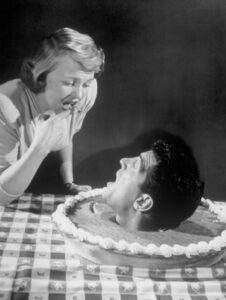
- You Was (Sonny Burke, Paul Francis Webster) Recorded December 14, 1948 – duet with Dean Martin
The 1948 comic duet “You Was,” with all its cleverly botched noun-verb agreement, was co-written by Sonny Burke and Paul Francis Webster, who that same year collaborated on a very different song that became a major entry in the Peggy Lee songbook: “Black Coffee.” Burke also became a songwriting collaborator of Lee’s with 1952’s “Sans Souci” and all the songs from Walt Disney’s Lady and the Tramp (1955). Lee’s duet partner was an up-and-comer named Dean Martin, in only his third session for Capitol, and this was Lee’s and Martin’s only pairing on record. Recorded in December 1948, this was Lee’s first time in a Capitol studio in nearly a year due to an American Federation of Musicians recording ban that sidelined most singers. Capitol’s ad promotions for the song in 1949 included a surreal photo of Lee standing alongside Martin’s head as it emerges from a pumpkin pie. The “You Was” single’s flipside was a Lee solo on “Someone Like You” from the movie My Dream Is Yours. Other labels competed with Capitol on the same duet: Columbia with Buddy Clark and Doris Day, Decca with Patty Andrews and Bob Crosby, and Mercury with Vic Damone and Patti Page. Lee sang duet versions on radio in 1949 with Martin as well as Clark and Haymes, all in episodes of The Chesterfield Supper Club, for which she served as a host; and with Bing Crosby on his radio show. Martin later recorded Lee’s songs “It’s a Good Day,” “Mañana” and “Where Can I Go Without You.” Lee appeared on ten episodes of Martin’s musical-variety show between 1965 and 1971, dueting with Martin each time but unfortunately never revisiting “You Was.”
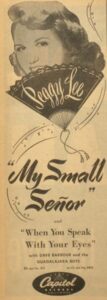
- My Small Señor (with the Sonriente Eyes) (Dave Barbour, Peggy Lee) Recorded December 2, 1949 – featuring the Guadalajara Boys
This song and a subsequent one, “When You Speak with Your Eyes,” share a body part (eyes), a recording date (December 2, 1949), a Capitol single release (#801), songwriting credits (Dave Barbour and Peggy Lee, in collaboration with Cuban composer, pianist and bandleader Rene Touzet on “Speak”), and vocal backing by the Guadalajara Boys. In early 1950 a Variety reviewer wrote, “‘My Small Señor’ particularly is a hefty potential…. It’s a really good cut. Reverse sells, too. Miss Lee delivers in her own style and though the tune is not as good, it has a chance.” Although neither song scaled the charts in the way “The Old Master Painter” did around the same time, discographer Ivan Santiago notes that both “Speak” and “Señor” enjoyed some regional success in California, Florida, Massachusetts, Missouri and New York.
- Wandering Swallow (Harold Stevens, Irving Taylor) Recorded May 16, 1951 – featuring the Jud Conlon Singers
Along with trains, birds were a common theme in many Lee recordings, including this one from a Billy May-led session featuring the Jud Conlon Singers, with whom Lee worked regularly on Bing Crosby’s radio show. “Wandering Swallow” first appeared on a Capitol single backed by “I Love You but I Don’t Like You,” co-written by Lee and Heinie Beau and featured on From the Vaults Vol. 3. “Swallow” is an English adaptation of the Brazilian song “Juazeiro” by Luiz Gonzaga and Humberto Teixeira. Singer Patricia Scot also recorded the English version.
- When You Speak with Your Eyes (Dave Barbour, Peggy Lee, Rene Touzet) Recorded December 2, 1949 – featuring the Guadalajara Boys
See “My Small Señor” entry above for some background about this song. Singer Frances Langford also recorded “When You Speak with Your Eyes.”
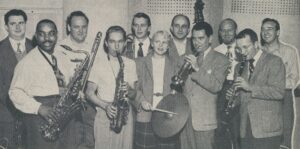
- Ja-Da (Bob Carleton) Recorded October 13, 1947 – instrumental by Ten Cats and a Mouse
This is an instrumental selection featuring Peggy Lee on drums, one of the true oddities in her Capitol Records catalog. “Ten Cats and a Mouse” was the name Capitol gave to “ten cats” of distinguished jazz pedigrees plus a “mouse” (Peggy), all playing instruments they had never previously recorded with. The ten cats consisted of Dave Barbour (trumpet), Benny Carter (tenor sax), Dave Cavanaugh (baritone sax), Hal Derwin (guitar), Frank DeVol (acoustic bass), Billy May (trombone), Eddie Miller (alto sax), Red Norvo (piano), Bobby Sherwood (trombone), and Paul Weston (clarinet). Although Lee fans may miss hearing a vocal, Bob Carleton’s 1918 song “Ja-Da,” with its well-known melody, is not known for its lyric sophistication. Lee’s friend Alec Wilder, in his landmark book American Popular Song, wrote, “It’s only a sixteen-measure bit of fluff, and yet I doubt if any even casual pop song listener would fail to recall it. It fascinates me that such a trifling tune could have settled into the public consciousness as ‘Ja-Da’ has.”
- Swing Low, Sweet Chariot (Traditional) Recorded January 6, 1956 – featuring male chorus
Lee had a strong appreciation for this beloved spiritual, recording it twice for Capitol (1946, 1947), again in 1946 as a transcription (a studio recording designed for radio play only), and this 1956 version for Decca. She sang it twice on her 1952 radio series, backed by her guest vocal groups the Golden Gate Quartet and Jud Conlon’s Rhythmaires; and on at least three television programs: Producers Showcase (1955), The Pat Boone Show (1958), and a 1970 Kraft Music Hall episode in duet with Johnny Cash. It was also in her concert repertoire as early as 1955 and as late as 1989. This 1956 version features male vocal backing and was conducted by the great arranger, conductor, trumpeter and singer Sy Oliver, whose orchestra backed Lee on 16 tracks in 1956, most of which appeared on her Decca album Miss Wonderful. This version of “Swing Low” first appeared on a 1959 Decca single, paired with “It Ain’t Necessarily So” by George and Ira Gershwin.

